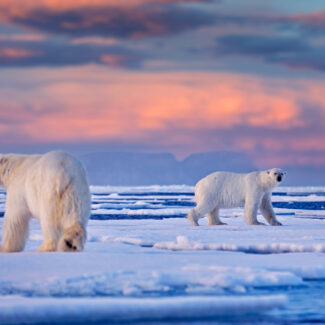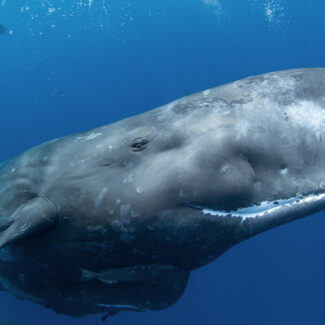5 Harp Seal Facts You May Well Harp On About To Your Friends
- (1) Harp Seals Undergo a Dramatic Color Change From Puphood to Adulthood
- (2) Growing Harp-Seal Pups Pack on the Pounds Rapidly—But Also Endure an On-the-Ice Fasting Period Before Hitting the Water
- (3) They Eat a Wide Variety of Prey (and Can Make Some Impressive Dives to Do So)
- (4) Three Populations With Separate Whelping Grounds Exist
- (5) They’re Vulnerable to Everything From Polar Bears to Greenland Sharks
- Where to See Harp Seals
Christened for the dark shape on their backs that resembles the namesake instrument, harp seals are among the most numerous of all the world’s pinnipeds, and certainly a critical link in the marine food web of the Arctic and the subarctic.
Found between eastern Canada and Russia in a distribution shadowing seasonal limits of pack ice—the platform harp seals use to rear their pups—this critter is among the handsomest of the poleward marine-mammal lineup, and always a thrill to spot out at sea.
In this article, we’ve rounded up five illuminating harp seal facts, including insights into harp seal habitat, harp seal diet, and the varied predators that’ll occasionally make a snack of them. We’ll wrap up with a little insight into which cruises you might choose if you want to potentially nab a glimpse of this eye-catching Arctic seal. Just try not to harp on about them too much to your friends or fellow passengers on your cruise!
(1) Harp Seals Undergo a Dramatic Color Change From Puphood to Adulthood
The adult harp-seal pelage with that defining dark dorsal pattern—which explains not only the common name but also such alternative monikers as “saddleback seal”—is, in fact, arguably not the species’ most iconic getup. That would probably be the snowy-white look of newborn pups, which are nicknamed “whitecoats” and are about as cute as mammals come. That suit only lasts a couple of weeks; then, pups transition into “graycoats,” where spotted gray underfur shows beneath the white, and then, thanks to the seal’s first major molt, to “beaters”: a phase defined by a spotted gray pelt and the clumsy, learning-to-swim splashing that gives this development stage its nickname.
Another molt occurs at a bit more than a year old, resulting in a retained spotted silvery suit; this is the “bedlamer” phase of a young harp seal. Rounds of annual spring molting gradually see the spots disappear, at least in the majority of harp seals, producing the adult pelage with the lyre-shaped mark on the back. Females tend to keep a silvery, spotted bedlamer or bedlamer-esque coat longer than males. Some adult harp seals, in fact, continue showing some spots on what’s otherwise the typical adult getup; these animals are often called “spotted harps.” Some male harp seals, meanwhile, develop a darkish, “sooty” coat with age.
This adorable white coat is just a phase! Harp seal pups undergo a stunning transformation, dramatically changing color as they mature into adults. It’s truly amazing to witness nature’s artistry.
(2) Growing Harp-Seal Pups Pack on the Pounds Rapidly—But Also Endure an On-the-Ice Fasting Period Before Hitting the Water
Harp-seal pups weigh about 25 pounds when they’re born on the springtime pack ice, a far cry from the 250- to 400-pound adults. But those youngsters gain weight rapidly, thanks to a couple of weeks or so of nursing on their mothers’ super-fatty milk. The pups bulk up at roughly five pounds per day, and in the process start thickening the blubber that’ll keep them toasty in the cold waters they call home.
That maternal gravy train phases out, though, when pups reach about 80 pounds or so and start weaning. Their moms head for sea, leaving their offspring to make do on the ice for some six weeks without sustenance. This means pups may lose as much as 50 percent of their body weight before they, too, finally head for the brine and start hunting for themselves.
This growing harp seal pup showcases the remarkable weight gain crucial for its survival. Yet, before diving into the frigid waters, these young seals endure a fascinating on-ice fasting period, a true test of their resilience.
(3) They Eat a Wide Variety of Prey (and Can Make Some Impressive Dives to Do So)
And what, exactly, do harp seals hunt? You wouldn’t call this pinniped a particularly picky eater, that’s for sure. As the U.S. National Oceanic & Atmospheric Administration notes, harp seals have been recorded munching on better than 130 different kinds of fish and invertebrates, with individual seals sometimes documented with many dozens of species in their bellies. That said, smallish fish such as Arctic and polar cod as well as capelin appear to be mainstays.
Capable of holding their breath for 16 to 20 minutes or so, harp seals are impressive divers, plunging down to depths of up to 1,300 feet. Adaptations for this deepwater foraging include the seal’s ability to slow its heart rate on dives and boost oxygen in the muscles and bloodstream, not to mention handy-dandy whiskers for feeling out prey in the darkness.
Observe these agile harp seals navigating the waves! Their impressive diving abilities allow them to hunt a diverse array of prey, showcasing their adaptability and crucial role in marine ecosystems.
(4) Three Populations With Separate Whelping Grounds Exist
A trio of “saddleback-seal” populations, each with its own distinct pupping H.Q. and harp seal migration pathway, are defined. The Northwest Atlantic population, the biggest of the three at better than seven million seals, inhabits the waters of eastern Canada and western Greenland and comprises three herds: the Front, Gulf, and North Gulf herds. Summering in Arctic waters of Canada and Greenland, the bulk of these Northwest Atlantic harp seals winter in the Gulf of St. Lawrence or seas off southern Labrador and northern Newfoundland. (This population may possibly constitute the most abundant stock of any marine mammal in the Northwest Atlantic.)
The Greenland Sea (or “West Ice”) harp-seal population is found off southeastern Greenland, while the White Sea/Barents Sea (or “East Ice”) population migrates between whelping grounds in Russia’s White Sea and summer range around the Svalbard and Franz Josef Land archipelagos in the Barents Sea.
This tender moment between a harp seal mother and pup highlights the critical bond formed on their whelping grounds. There are three distinct populations, each returning to their specific icy nurseries to raise the next generation.
(5) They’re Vulnerable to Everything From Polar Bears to Greenland Sharks
Several aquatic predators pose a risk to the harp seal, most notably the orca (or killer whale) and the Greenland shark. Harp seals were among the pinnipeds on Sable Island, Nova Scotia that were observed killed or wounded by sharks, with bite patterns suggesting the majority of attacks were perpetrated by Greenland sharks and a minority by great white sharks. While sluggish-looking and often slow-swimming, Greenland sharks appear capable of quick bursts of speed, as stomach-content analyses suggest many consumed marine mammals and other swift prey were actively preyed upon rather than scavenged.
Harp seals may be taken by polar bears when hauled out on pack ice, surfacing to breathe amid floes, and potentially while swimming near the edge of the ice. A study documenting opportunistic polar-bear predation on hauled-out harp seals off Svalbard during the summer suggested harp seals there lack a strong predator response to bears: Polar bears killed multiple seals without eliciting visible alarm or escape behavior in other seals nearby. The researchers hypothesized that harp seals overall are generally only minimally exposed to significant polar-bear predation, normally only hauling out on sea ice briefly in the spring as they do to pup, and therefore aren’t as behaviorally attuned to the risk as are more typical bear prey such as ringed and bearded seals. In Svalbard, harp seals normally forage offshore, pelagic haunts that keep them basically out of reach of polar bears. The summertime haul-outs the study focused on were, the authors proposed, probably related to specific occurrences of prey—Arctic cod, perhaps—under the ice that drew the seals into (and onto) the pack, where they can make easy pickings for bears.
With watchful eyes, this harp seal navigates waters where dangers lurk, from polar bears to Greenland sharks. It’s a poignant reminder of the many challenges these incredible creatures face in their natural habitat.
Where to See Harp Seals
On the Arctic cruises we offer, harp seals are a potential highlight of tours, for example, to Svalbard, Greenland, and the Northwest Passage through the Canadian Arctic. The main summertime cruising season offers opportunities to observe these seals particularly in their beater, bedlamer, and adult pelages.
Disclaimer
Our travel guides are for informational purposes only. While we aim to provide accurate and up-to-date information, Antarctica Cruises makes no representations as to the accuracy or completeness of any information in our guides or found by following any link on this site.
Antarctica Cruises cannot and will not accept responsibility for any omissions or inaccuracies, or for any consequences arising therefrom, including any losses, injuries, or damages resulting from the display or use of this information.









